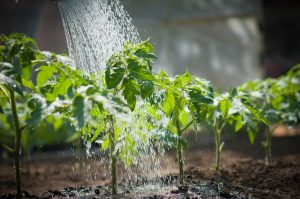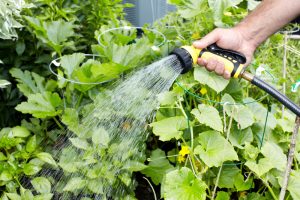It’s August, the hottest month of the year. Just like animals, plants are thirsty beings during this month. This guest post by gardener Leslie Shearer addresses two common watering mistakes. Read on to learn more about how to water your garden…
Regarding gardening problems, the two most commonly encountered issues are the
frequency of watering and how to properly apply water to your garden. Water plays a
critical role in the garden, so if you water carelessly and incorrectly, then many
problems including diseases may arise.
You may think that watering the garden every other day, or every day, or even in
hot weather is important. However, in reality, this is sometimes not necessary,
even when you are planting a new garden.
Below are hints on how to properly water your garden:
RELATED POST: Plants That Can Do Without Water
Focus on the root zone

Make sure that instead of providing the leaves with more water, you should make
the roots wet. It is such a waste of water to wet the foliage. In practice, watering
the foliage can encourage plant-based diseases to spread more quickly.
Water only when needed
To ensure proper and consistent watering automatic timers are considered a highly
useful tool. Also, you need to observe the weather regularly to be able to adjust the
amount of water as well as the frequency of watering. Remember that if you water
too much, plants are easily inclined to be damaged or even die.
Water deeply and thoroughly
It sounds a little absurd, but you don’t necessarily need to water your plants daily.
You just need to water them more deeply. Watering too much is likely to cause
some fungal problems in vegetables which grow well in drier conditions such as
tomatoes and squash. Therefore, it is necessary to make the soil a little drier.
If you water the plants shallowly and frequently, their roots may emerge on the
surface. Certainly, this is not what you want to see, so water in moderation. After
watering, allow complete absorption into the soil, helping the roots develop more
deeply on the ground.
Water in the morning

It is commonly known that watering plants in the early morning will benefit them
most.
Horticulture Magazine states that it is much easier for the plant roots to absorb
water in the evening and morning but midday isn’t the right time. In short, the night
or day is also a good time. Also, watering early in the morning helps reduce the
evaporation or water loss under sweltering conditions.
Use the right tool
It is also recommended to use a soaker hose to water the root zone efficiently. A
soaker-hose irrigation system includes a rubber hose with tiny pores on it which
leak water out. The hose can be curved surrounding the plants or laid between
rows. Compared to a drip irrigation system, a soaker-hose system is much easier to
use because it contains no nozzles and fewer parts.
Water before you mulch
Mulch helps to prevent water loss in the soil. However, it is better if you water the
soil first and then cover it with mulch because apart from blocking the evaporation,
mulch also makes it difficult for the intrusion of water into the roots. Additionally,
this also helps your plants avoid waiting for water. The mulch also makes a
significant contribution to eliminating thirsty weeds which require water too.
Mulch, mulch, mulch

If you intend to grow plants in bare soil, you should consider mulching. Such bare
soil will create favorable conditions for weeds to develop and as a result, your soil
will consume water more quickly, become dry and even cracking in the ground can
occur because of it lacking proper levels of moisture.
It is recommended to mulch thickly with leaves, straw or hay because this helps
provide your soil with organic matter, reduce the risk of diseases, prevent the
development of weeds and keep the soil moist all the time. (Read more about
mulch here.)
Group crops together that have similar watering needs
It is important to choose the correct position for each plant, for example for light
water users such as squash and beans; you should plant them at one side of the
garden while planting heavy users like broccoli and beets at the other. After that,
you can devise a separate water regime to suit the type of plant being watered.
Cut down on cultivation
Working the soil a lot will make it dry more quickly.
If you want to get rid of weeds, you can cover your soil with mulch instead of
burying them.

Author Bio:
Leslie J. Shearer is the founder and owner of the blog colorgardening.com. Gardening is her passion and she has a deep relationship with nature. Growing plants and digging deep to germinate flowers and vegetables brings positivity into her life.



